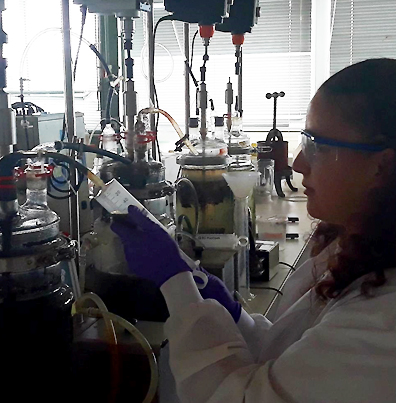PhDS

Doha ELALAMI
The world population growth has led to increased use of water resources resulting in high wastewater generated quantities. Wastewater sludge, which is the residual waste from the various water treatment stages, is generally landfilled, spread or incinerated.
Anaerobic digestion (AD) is one of the most widely used valorization routes for sludge. It is one of the most mature and energy-efficient biological processes. In general, several types of organic wastes can be subjected to AD among which we find lignocellulosic wastes. Generally, lignocellulosic biomasses have higher methane potential than sludge and thus can increase the biogas production if they are co-digested. However, lignocellulosic wastes are hardly degradable due to the presence of lignin and cellulose which resist to the biological reactions during AD process. The aim of this thesis is to improve methane production from sludge and lignocellulosic wastes, though their co-digestion, pretreatments and their combining. In addition, the remaining digestate are valorized as soil fertilizers due to its nutrients content.

Saïda TAYIBI
Energy valorization of biomass and production of biofertilizers based on biochars, digestates and composts.
The main objective of this work is the development of biotechnological itineraries via biological and thermal bioprocesses in order to better exploit biomass / waste in Morocco (olive residue, tomato residues, industrial waste, algal biomasses ) and effluents (wastewater and anaerobic digestion effluents) to obtain energy and biofertilizers based on biochars, digestates and composts.

Saloua FERTAHI
Conception of phosphorus fertilizers coated using biopolymers: Efficiency and Impact on the chemical and biological soil quality.
The aim of our project is to improve the eco-efficiency of mineral fertilizers (NPK) using wastes and biomasses. We intend to check if a new generation of fertilizer with controlled release can be developed, by using biopolymers resulting from biomass and organic waste, available in large quantities in Morocco and at low costs. The coating of fertilizers by biopolymers and the production of coated mineral fertilizers. The expected results are, a better knowledge of coating techniques in adequacy with biopolymers proprieties, the determination of the parameters of nutritive elements release and their biodisponibility in the soil.
Post Doc

Chahinez BENADIS
Using microalgae for wastwater teratment and agro-industrial effleunts valorisation pour biofertilizers production
Microalgae are now attracting increasing interest as the applications that converge around these cells are numerous. There are today a multitude of scientific and technological obstacles that deserve to be removed, crossroads of innovation between agro-ecological approach and techno-economic vision. Microalgae already used as food supplements, in cosmetics, health, green chemistry and biomaterials as well as in biofuel. The choice of microalga, culture medium and cropping system is a major goal in the ATLASS project. The ATLASS1 project proposes to explore other ways of valorization and eco-efficient process for the valorization of micro-algae: The selective conversion for the production of bio-products / bio-polymers serving as base for fertilizers of new generation (to based on biopolymers or biofertilizers including microorganisms) or fertilizers resulting from the residues of the energy sector (composts, biochars, microalgae and digestates) which aim to improve the chemical, physical and biological properties of soils while replacing industrial fertilizer

Garcia Sanchez Mercedes
Novel strategies in developing bio-fertilizers increasing in phosphorus plant uptake
The main goal of my research project is based on the development of bio-fertilizers with potential capacity to solubilize the soil inorganic phosphorus (Pi), thus favoring the subsequent plant uptake. The principal strategy in this project, is the bio-encapsulation of potential strains presenting key mechanisms involved on Pi solubilisation. However, new formulations based on the fermentation of biomass supplied with phosphate naturel and bio-fertilizers might present a suitable strategy improving P plant uptake reducing the disadvantages in the classical formulations which includes live microorganisms.

Mohamed Ilsouk
New generation bio-fertilizers from renewable raw materials: elaboration of coated fertilizers based on biopolymers.
The main objective of this work is to extract biopolymers from different biomass resources, purify them and enhance their properties (mechanic, barrier, thermal …) thereafter by developing composites (polymer / polymer) with other polymers and nanocomposites (polymer / nanofillers) with nanofillers such as (clays, hydroxyapatites…) in order to have materials with potential applications in agriculture.

Nour-El houda FAYOUD
Production of biochar and bio-oil from different agro-waste biomass after several pretreatment in order to improve the energy recovery from agricultural wastes and testing the agronomic quality of produced biochars as soil amendment and contamination adsorbents
- Several agro-waste biomass were selected and will be mechanically and/ chemically pretreated and characterized.
- Umpretreated and pretreated selected agro-waste will be pyrolized for biochar, bio-oil and sungaz production and will be characterized to evaluate the effect of different tested pretreatment on the three products yield and properties.
- Produced biochars at lab scale will be tested as adsorbents for wastwater tratment.

